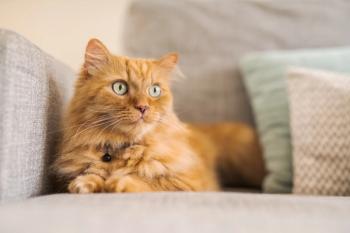
What are the best practices for antibiotic use in pneumonia, bronchitis and pyothorax?
In pneumonia and pyothorax cases, treatment while awaiting test results is recommended, but not in bronchitis cases.
The following article is the last in a three-part series summarizing information from
(Shutterstock)The new document gives guidelines for the treatment of pneumonia, pyothorax and bronchitis, in both cats and dogs.
Bronchitis
Bronchial inflammation can be caused by a variety of factors ranging from environmental irritants to parasites to viral or bacterial pathogens. Bordetella bronchiseptica and Mycoplasma species are the primary bacterial pathogens associated with bronchitis. Dogs and cats with underlying inflammatory or immune disease or anatomic defects (e.g. would be fine laryngeal paralysis, tracheal collapse) might be susceptible to secondary bacterial bronchitis.
Diagnosis of bacterial bronchitis requires tests to rule out other causes and collection of samples from the lower airways for cytology and bacterial culture and antimicrobial susceptibility testing. The guideline authors note that bronchoscopy is the preferred method for obtaining samples, but tracheal washing may also be considered.
With respect to treatment, the guideline authors recommend that no treatment be initiated while awaiting culture results unless the clinical signs are severe. In that instance, doxycycline can be given for seven to 10 days (5 mg/kg orally every 12 hours, or 10 mg/kg orally every 24 hours). While the optimal duration of therapy is not clear, if the patient has a positive response to the initial regimen, the guideline authors recommend continuing therapy one week past resolution of the clinical signs. Nonbacterial causes of bronchitis should be considered for patients that do not respond to therapy.
Pneumonia
Bacterial pneumonia in dogs and cats is most often secondary to other events such as viral infection, aspiration or immunodeficiency. Common organisms include Escherichia coli, Pasteurella species, Streptococcus species, B. bronchiseptica, Enterococcus species, Mycoplasma species and Staphylococcus pseudintermedius.
Samples for cytology and aerobic/anaerobic bacterial culture and antimicrobial sensitivity testing can be collected via transtracheal, endotracheal or bronchoalveolar lavage. For patients that are too ill to undergo any type or airway sampling, blood cultures may be considered. Consultation with a specialist may be helpful in these cases.
The guideline authors recommend beginning administration of antibiotics while awaiting results, with consideration given to anaerobic coverage, particularly in patients with pneumonia secondary to aspiration or in the presence of grass awn foreign body migration. Further, the authors recommend parenteral antibiotics for patients with pneumonia, regardless of disease severity, with continued oral antibiotics once the patient is discharged. For patients with mild disease in which infection with B. bronchiseptica or Mycoplasma species is suspected, doxycycline alone may be considered (5 mg/kg orally or intravenously every 12 hours). Use of broader spectrum antibiotics, such as fluoroquinolones and penicillins, should be considered for patients with evidence of systemic illness (e.g. fever, injected mucous membranes, respiratory distress).
The guideline authors acknowledge that, while the typical duration of therapy is four to six weeks, the optimal duration for a patient with pneumonia is unclear. Rather, they recommend that the patient be re-evaluated within 10 to 14 days of starting therapy. Continued care should be based on clinical, hematological and radiographic response to treatment.
Pyothorax
Infection in the pleural space is often a mixture of anaerobic bacteria, most often from migrating plant foreign bodies (dogs) or cat fights (cats). In addition to radiographs to look for lung consolidation, samples of pleural fluid should be submitted for cytology and culture.
In these patients, the drainage of infected fluid from the pleural space is even more important than the administration of parenteral antibiotics. The guideline authors recommend that this should occur via intermittent or preferably continuous suction with or without lavage. The main comment was that evidence to support a definitive need for thoracic lavage is insufficient. The guideline authors do not recommend administration of antibiotics into the pleural space because of the lack of data supporting this use.
While awaiting culture results, empirical therapy with a fluoroquinolone and penicillin or clindamycin should be initiated. The guideline authors recommend antibiotics with anaerobic coverage as well, regardless of culture results, since these organisms are often difficult to culture and yet commonly implicated in pyothorax.
Optimal duration of therapy is unknown, but four to six weeks is common and will depend on clinical response. Follow-up radiographs should be performed at least 10 to 14 days after starting therapy.
Table: First-line antimicrobial options
Type of infection
First-line drug options
Bacterial bronchitis
(dogs or cats)
Doxycycline: 5 mg/kg PO every 12 hours, or 10 mg/kg PO every 24 hours
***Changes should be based on clinical responses and culture and antimicrobial susceptibility testing if available.
Pneumonia with no
systemic signs of illness
and when Bordetalla bronchiseptica or Mycoplasma species
are suspected
(dogs or cats)
Doxycycline: 5 mg/kg PO or IV every 12 hours, or 10 mg/kg PO every 24 hours
Pneumonia with or without clinical evidence of sepsis (dogs or cats)
Parenteral administration of a fluoroquinolone and a penicillin or clindamycin initially.
Enrofloxacin:
--Dogs: 5-20 mg/kg PO, IM, IV every 24 hours
--Cats: 5 mg/kg PO every 24 hours
Ampicillin-sublactam: 20 mg/kg IV or IM every 6 to 8 hours
Ampicillin sodium: 22-30 mg/kg IV or SC every 8 hours
***Choice of oral drugs should be based on clinical responses and culture and antimicrobial susceptibility results if available.
Pyothorax
(dogs or cats)
Parenteral administration of a fluoroquinolone and a penicillin or clindamycin initially; should be combined with therapeutic lavage initially.
Enrofloxacin:
--Dogs: 5-20 mg/kg PO, IM or IV every 24 hours
--Cats: 5 mg/kg PO every 24 hours
Ampicillin-sulbactam: 20 mg/kg IV or IM every 6 to 8 hours
Ampicillin sodium: 22-30 mg/kg IV or SC every 8 hours
Clindamycin:
--Dogs: 10 mg/kg PO or SC every 12 hours
--Cats: 10-15 mg/kg PO or SC every 12 hours
***Choice of oral drugs should be based on clinical responses and culture and antimicrobial susceptibility results if available.
Lappin MR, Blondeau J, Boothe D, et al. Antimicrobial use guidelines for treatment of respiratory tract disease in dogs and cats: Antimicrobial Guidelines Working Group of the International Society for Companion Animal Infectious Diseases. J Vet Intern Med 2017;30:279-294.
Link to article:
Newsletter
From exam room tips to practice management insights, get trusted veterinary news delivered straight to your inbox—subscribe to dvm360.






